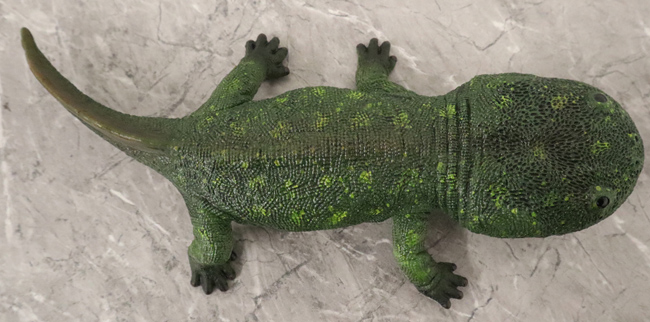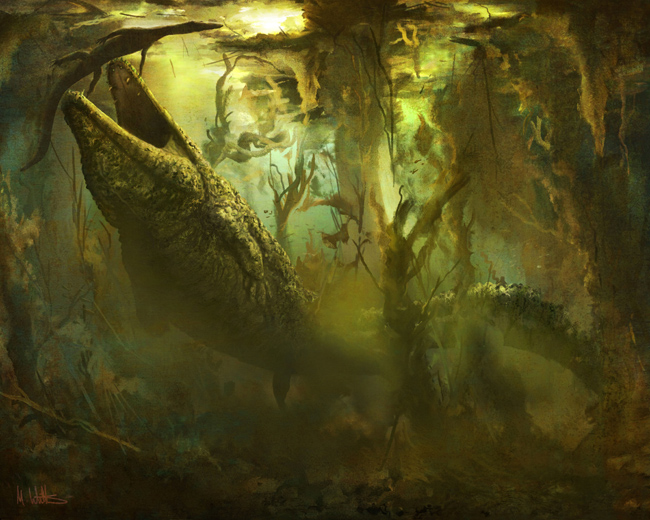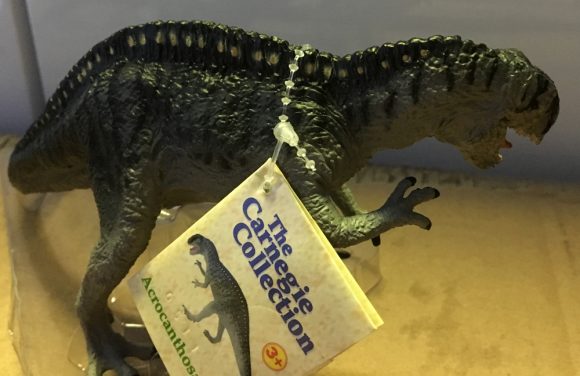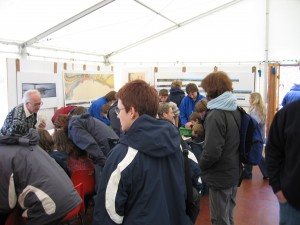Recently published temnospondyl research suggests that adopting a generalist feeding ecology helped these ancient amphibians to survive the end-Permian mass extinction event. The study published this week in the journal “Royal Society Open Science”, concludes temnospondyl’s success lay in their generalist feeding ecology. The temnospondyls consist of an extinct clade comprising around three hundred known species. They evolved in the Early Carboniferous and persisted until the Early Cretaceous. This represents a timespan of around two hundred and thirty million years. Temnospondyls were traditionally classified as amphibians, although their taxonomic affinity with the Amphibia remains controversial. It is more technically correct to refer to these vertebrates as anamniote tetrapods.

A dorsal view of the CollectA Deluxe Koolasuchus a late surviving temnospondyl from the Early Cretaceous of Australia. Picture credit: Everything Dinosaur.
Picture credit: Everything Dinosaur
The photograph (above) shows a dorsal view of Koolasuchus cleelandi model. It is the youngest temnospondyl described to date. Fragmentary fossils are thought to be around 125-120 million years old (Barremian – Aptian faunal stages of the Cretaceous). The model is from the CollectA Deluxe range of scale prehistoric animal figures.
To view this range of prehistoric animal models: CollectA Deluxe Prehistoric Life Models.
A Mystery of the end-Permian Mass Extinction Event
One of the mysteries of the end-Permian mass extinction was the subsequent success of temnospondyls. This catastrophic global event occurred approximately 252 million years ago. It was the largest extinction event in the Phanerozoic, marked by the loss of as many as 90% of all species. Although many types of temnospondyl died out, following this mass extinction temnospondyls diversified rapidly during the Early Triassic. Numerous lineages arose. These lineages continued, although with diminishing diversity throughout the remainder of the Triassic. A few taxa survived into the Jurassic before the temnospondyls are thought to have finally become extinct during the Early Cretaceous.
Researchers led by scientists from the University of Bristol propose that these animals thrived after the mass extinction event by feeding on freshwater prey that evaded terrestrial predators.
By adopting a generalist feeding ecology, these predators could consume a wide variety of prey despite all the environmental changes going on during the Triassic. A broader examination of Triassic ecosystems also indicates that the freshwater habitats temnospondyls preferred provided them with a relatively stable variety of food resources. This allowed them to thrive while strictly terrestrial predators made do with meagre, unstable resource availability on land.

A Mastodonsaurus rises out of the depths to ambush a small, archiosauriform (Jaxtasuchus). Picture credit: Mark Witton.
Picture credit: Mark Witton
Mastodonsaurus (see image above), is known from the Middle Triassic of Europe. It was one of the largest temnospondyls, with an estimated body length of more than five metres.
Lead author of the study Aamir Mehmood (University of Bristol School of Biological Sciences), commented:
“One of the great mysteries has been the survival and flourishing of a major group of amphibians called the temnospondyls. These were predatory animals that fed on fishes and other prey, but were primarily linked to the water, just like modern amphibians such as frogs and salamanders. We know that climates then were hot, and especially so after the extinction event. How could these water-loving animals have been so successful?”
The Triassic “Tropical Dead Zone”
The Early Triassic was a time of repeated volcanic activity leading to long phases of global warming, aridification, reductions in atmospheric oxygen, acid rain and widespread wildfires, creating conditions so hostile that the tropics became devoid of animal life. This “tropical dead zone” drastically impacted the distributions of both marine and terrestrial organisms.
Co-author Dr Suresh Singh said:
“We collected data on a hundred temnospondyls that lived throughout the Triassic and wanted to look at how their ecologies changed. We measured their body sizes and features of the skulls and teeth that tell us about function.”
Dr Armin Elsler another co-author of the temnospondyl research paper added:
“Much to our surprise, we found that they did not change much through the crisis. The temnospondyls showed the same range of body sizes as in the Permian, some of them small and feeding on insects, and others larger. These larger forms included long-snouted animals that trapped fishes and broad-snouted generalist feeders. What was unusual though was how their diversity of body sizes and functional variety expanded about five million years after the crisis and then dropped back.”
Due to the intense global warming of the first five million years of the Triassic, there is evidence that life on land and in the sea moved away from the tropics to avoid the heat.
Professor Mike Benton (University of Bristol) explained:
“Our work shows that the temnospondyls, unexpectedly, were able to cross the tropical dead zone. Fossils are known from South Africa and Australia in the south, as well as North America, Europe and Russia in the north. The temnospondyls must have been able to criss-cross the tropical zone during cooler episodes.”

An exhibit featuring a reconstruction of the skeleton of the giant Permian temnospondyl Eyrops. New research suggests that temnospondyl’s success during the Early Triassic lay in their generalist feeding ecology. Picture credit: Everything Dinosaur.
Picture credit: Everything Dinosaur
The Decline of the Temnospondyls
Aamir summarised the team’s findings stating:
“Their burst of success in the Early Triassic was not followed up. They coped with the hot conditions probably by having a low requirement for food, by being able to eat most prey animals, and by hiding in sparse water bodies. But when the ancestors of dinosaurs and of mammals began to diversify in the Middle Triassic, the temnospondyls began their long decline.”
Everything Dinosaur acknowledges the assistance of a media release from the University of Bristol in the compilation of this article.
The scientific paper: “The ecology and geography of temnospondyl recovery after the Permian – Triassic mass extinction” by Aamir Mehmood, Dr Suresh Singh, Dr Armin Elsler and Professor Michael Benton published in Royal Society Open Science.
The award-winning Everything Dinosaur website: Prehistoric Animal Models and Toys.

















